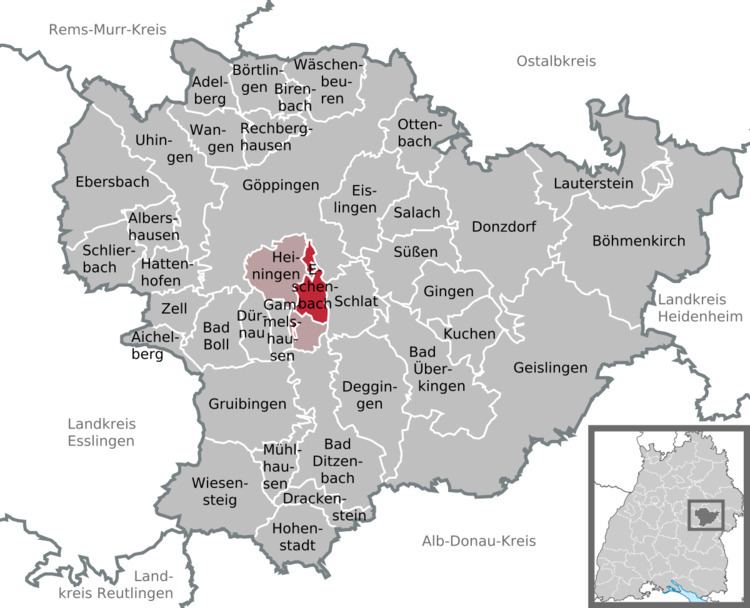Admin. region Stuttgart Time zone CET/CEST (UTC+1/+2) Area 4.8 km² Postal code 73107 Dialling code 07161 | Postal codes 73107 Population 2,211 (31 Dec 2008) Local time Tuesday 9:55 PM Administrative region Stuttgart | |
 | ||
Weather 3°C, Wind SW at 10 km/h, 89% Humidity | ||
Eschenbach is a municipality in the district of Göppingen in Baden-Württemberg in Germany.
Contents
- Map of Eschenbach Germany
- Geographical location
- Overview
- Neighboring communities
- Municipality arrangement
- Early History
- Middle Ages
- 20th century
- Population Development
- Space division
- Council
- Economy and Infrastructure
- Preschools
- Schools
- Regular events
- Personality
- References
Map of Eschenbach, Germany
Geographical location
Eschenbach is located in the valley of the river of the same name, at the foot of the Swabian Jura. The district town Göppingen is 6 kilometers away.
Overview
With an area of 480 ha Eschenbach is one of the smallest villages in the district of Göppingen. Through its location in the area before the Swabian Jura the municipality has however developed from a farming community to a municipality with around 2,200 inhabitants.
Neighboring communities
Since 1970, the municipality forms together with the neighboring community Heiningen the Gemeindeverwaltungsverband Voralb. (Administration Unit Voralb).
Municipality arrangement
Eschenbach includes the village Eschenbach, the hamlet Lotenberg (also to community Heiningen) and the homestead Iltishof and the dialed villages Hag and Bürstenhof.
Early History
The probable beginning of settlement for the place is between the 9th and 13th centuries. Eschenbach means ash-trees at a river. The eponymous Eschenbach springs beneath the "Weisse Mauer" (white wall) on the Fuchseck mountain. The first written reference does not refer to the place, but to the church on the Lotenberg. In 1228, in a document of the Abbey of St. Gall, a pastor, and thus a church, is mentioned on the Lotenberg. The group of houses on the Lotenberg still conveys the image of a castle building.
Middle Ages
Especially Eschenbach is first mentioned in 1379 in a deed of sale of the Counts of Helfenstein. It changed hands of several owners and was finally divided from 1476: two thirds from Iltishausen (Iltishof) and Lotenberg belonged to the barons of Liebenstein, the rest was owned by the monastery of Adelberg and after the Reformation since 1534 by the Duchy of Württemberg. Until 1867 Eschenbach was administered by Adelberg, later by the Oberamt Göppingen.
20th century
The place was until after the Second World War dominated by agriculture. The place lived mainly from the animals: cattle, horses and sheeps, especially because the arable soils were not very productive. An important role played also the fruit growing, particularly encouraged by the pastor Johann Christian Engel, the father of Dr. Theodor Engel.
Population Development
The inhabitants of the community: Development 1837-2010.
Space division
According to data of the State Statistical Office Baden-Württemberg in Stuttgart, as of 2014.
Council
The council of Eschenbach has 10 members. The local elections on 25 May 2014 led to the following official results. The council consists of the elected honorary councilors and the mayor as chairman. The mayor is entitled to vote in the municipal council.
Economy and Infrastructure
The Gewerbepark Göppingen-Voralb an association of the city Göppingen and the municipalities Eschenbach and Heiningen, has erected the industrial park Göppingen-Voralb with approximately 29 ha.
Preschools
The kindergarten is located in the Theodor Engel meetinghouse. Since 1992 the civic community has a further kindergarten. Thereby, the municipality is able to offer at any time every three year old child a place in a kindergarten in the community.
Schools
The primary school includes the primary classes 1 to 4; currently are visiting over 100 students primary school. The Hauptschule is located in the neighboring municipality Heiningen. Schools of all types are available in Göppingen.
Regular events
The annual herb festival recalls the earlier significant herb cultivation.
Personality
Sons and daughters of the town
